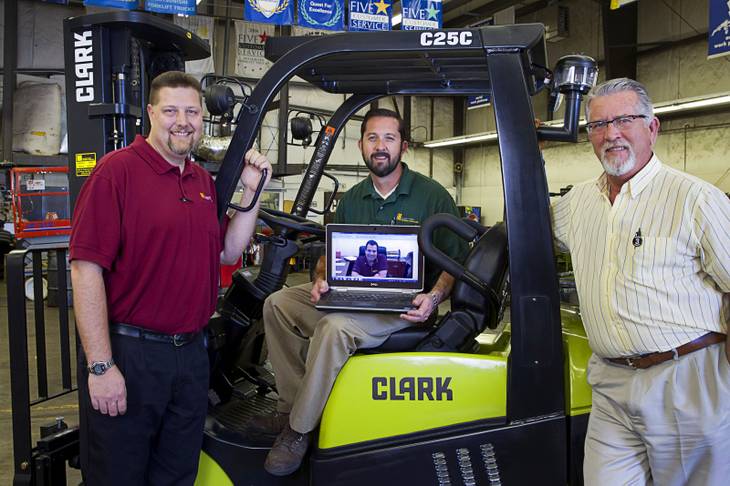In Las Vegas and across the country, many self-starting employees have shed the shackles of on-site, whip-cracking bosses to enjoy the freedom offered by virtual or remote offices. Working from home a few — or maybe a few thousand — miles away from bosses is becoming increasingly popular. It’s a setup both remote bosses and their workers enjoy.
“It’s part of the cyber world we now live in,” said longtime Los Angeles Times reporter John Glionna, who covers the Southwestern United States from his home in Henderson and reports to editors in Los Angeles.
Rick Kwiatkowski, vice president of Phoenix-based Inland Hobbs Material Handling, which rents and sells forklifts and other heavy equipment, said if a company expects to expand and be successful in today’s high-tech world, satellite offices are becoming a necessity.
“If you are the kind of business owner who has to have his hands on every phase of operation, then your company will have great difficulties growing, because you’ve become the bottleneck,” said Kwiatkowski, who oversees offices in Arizona, California, northern Mexico and Las Vegas. “You have to trust the people you have hired to do their jobs.”
Tips for remote workers
• Don’t be invisible. Build relationships with co-workers and bosses via email, instant message, social media or telephone. Communicate about work, but ask about kids and weekend plans, too.
• Eliminate distractions. Figure out how, where and when you work best. Set, and keep, specific work hours.
• Be reliable and meet deadlines.
• Show your face. If possible, visit company headquarters to meet people and catch up with your boss in person.
• Let people know when you aren’t working. Set up “lunchtime” or “Be right back” messages to let others know you may not respond immediately.
Thirty-five Inland Hobbs employees — and no bosses — work at 4265 W. Tropicana Ave. They report to corporate bosses in Arizona, who in turn provide daily reports from all of the company’s satellite offices. Kwiatkowski regularly visits each site, sometimes unannounced, to review operations.
Sixty-three percent of companies reported workplace flexibility in 2013, up from 34 percent in 2005, according to the Families and Work Institute. The 2010 census found that 13.4 million workers — just shy of a tenth of the U.S. workforce — worked at least one day from home each week. And in 2014, nearly four of every 10 employees surveyed by Gallup said they spent some time working remotely.
Perhaps the biggest challenge of letting employees work away from the watchful eyes of supervisors is that management must trust employees not to abuse their freedom and be as productive on their own as they would be in the main office.
Glionna said his independence results in an even more strenuous work ethic.
Tips for managers
• Clearly set and define goals and expectations. Make sure remote employees know and understand job parameters. When they deliver good results, make sure their work is acknowledged and recognized.
• Schedule regular conversations and meetings with employees. Keep a list of topics to discuss and encourage employees to do the same.
• Pick up the phone. Email and instant message can be effective for many tasks but not all. Sometimes the best way to communicate is with a conversation. Don’t be afraid to call or videoconference with workers.
• Meet new hires. Make a point to meet face-to-face with new employees, even if that requires travel, and if possible, set aside a decent amount of time to train them in person.
“I work harder and put in more hours now than I did when I worked at the mothership,” Glionna said. “In the main newsroom in L.A., there are hundreds of people to socialize with, go to hourlong lunches with and take breaks with. But here, I often work through lunch. If I end my workday at 6:30 p.m., I may still work on the story later that night.”
Glionna has worked for 15 years without a boss in the room. He estimates he generates 90 percent of his own story ideas and works on as many as 12 stories at any given time. But Glionna said he is never more than a phone call, email or instant message away from his boss.
“I once got a cellphone call from an editor when I was halfway around the world in the jungles of Sumatra,” Glionna said. “It was daytime where I was and the middle of the night in Los Angeles. Believe me, in almost any job, your boss can track you down.”
Kwiatkowski said he doesn’t lose sleep worrying his employees might be goofing off because he hires people who take pride in their work.
“If a forklift breaks down on the job, work at a site can come to a standstill, and on big construction projects, that can mean heavy financial losses for the customer,” Kwiatkowski said. “Our repair employees are well aware of this and, without being told to do so, do their best to get to a job site as quick as possible to get that equipment up and running.’’
Where do you go?
When working remotely, 64 percent of employees said they are most productive at home.
• 18 percent said they are most productive at a co-working space.
• 6 percent said they are the most productive working from a coffee shop or café.
For their part, his Las Vegas employees seem to enjoy the arrangement. Kwiatkowski said staff turnover is very low.
“Remote operations, I suspect, will continue to evolve as communication technology evolves,” Kwiatkowski said. “Such operations will get more efficient as we do a lot more with telephones, video conferencing and whatever else comes along in the future.”

